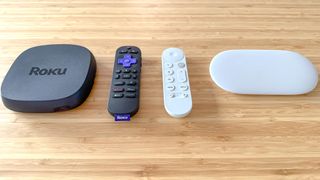
Roku and Google leverage some of the best streaming devices on the planet, and both brands recently rolled out new $99 models built for serious performance. That's a relatively high price tag, but these models offer a wide range of features beyond just access to the best streaming services.
The newly-introduced Roku Ultra, a refreshed version of the premium model originally released back in 2015, offers up to 30% faster speeds than its predecessors. We'll have to give this a run for its money in an official review later in the month, but by all accounts, the upgrades seem promising.
As for Google's new entry, it's dropping the long-lived Chromecast with Google TV name in favor of the Google TV Streamer. The name is far less of a mouthful but one that reflects new nomenclature. It takes on a whole new design that extends even to its remote control. It also features several baked-in AI enhancements, namely a screensaver function to take on the Samsung The Frame TV.
Read on to find out which new premium streaming device is a worthy upgrade for your TV.
Roku Ultra (2024) vs Google TV Streamer: Specs compared
| Header Cell - Column 0 | Roku Ultra (2024) | Google TV Streamer |
|---|---|---|
| Ports | USB 3.0, HDMI 2.1b, Ethernet (10/100) | USB-C, HDMI 2.1a, Ethernet (10/100/1000) |
| Refresh rate | 60Hz (with QMS) | 60Hz |
| Storage | N/A | 32Gb |
| Resolution | 3,840 x 2,160p | 3,840 x 2,160p |
| HDR | HDR10, HDR10+, HLG, Dolby Vision | HDR10, HDR10+, HLG, Dolby Vision |
| Smart TV software | Roku OS | Google TV |
| Price | $99 | $99 |
Roku Ultra (2024) vs Google TV Streamer: Design
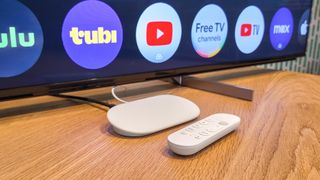
Roku maintained the Ultra's minimalist look and hasn't added any new color schemes for its refreshed model. In fact, if you look at them side by side, you can't really see much of a difference.
The Google TV Streamer, on the other hand, is a completely new look for Google. It uses a sloped structure, almost like a small skateboard ramp, and comes in two colors: Hazel and Porcelain. Even the remote sees a major alteration with a longer design and volume controls that now sit on the front of the device.
Roku followed in Google's footsteps, including its redesigned Voice Remote Pro in the box. This bad boy is charged via USB-C and even has backlit buttons, putting Google's new remote to shame. (Who wants to constantly be changing batteries and fiddling with controls in the dark when you've got unlimited power and backlit buttons?)
Both streaming devices are rather bulky compared to their counterparts and will take up space somewhere close to your TV. They'll also show their wires, but you could get around that by stashing them conveniently behind your TV.
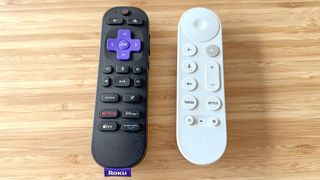
The Roku Ultra and Google TV Streamer make use of different ports. The Ultra leverages a USB 3.0, HDMI 2.1b and Ethernet that can only hit 100 Mbps of speed. Meanwhile, the Google TV Streamer has power and data connectivity with USB-C, HDMI 2.1a and Ethernet that hits up to 1Gb wired.
It's also important to note that the Roku Ultra uses WiFi 6 (2.4 Ghz / 5 GHz), while the Google TV Streamer sports just WiFi 5. The Google TV Streamer, however, offers a Thread board router for smart home connectivity and improved collaborations across your Thread and Matter-based smart home ecosystem. The Roku Ultra does not.
That's not to say the Ultra doesn't have smart home capabilities, though. They're just locked behind Roku's cheap smart home devices, meaning you have to use the Roku Light Strips, Roku Doorbell Camera, and more for proper functionality. Thus, if you're well-invested in the Roku ecosystem, the new Ultra might be the perfect match, but even with its better remote, the TV Streamer wins out.
Winner: Google TV Streamer
Roku Ultra (2024) vs Google TV Streamer: Performance
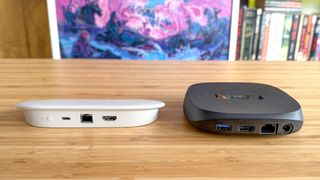
The Chromecast with Google TV 4K is now dead. Taking its place is the Google TV Streamer. It's a powerful little device with a ton of support beyond just entertainment needs, extending even into the smart home realm with a Thread board router. Gemini also makes massive strides with summarized reviews and overviews of shows, plus better recommendations to find your next favorite show or movie.
In our review of the new Google TV Streamer, we praised the redesigned remote, enhanced smart home controls, and AI screensavers. In terms of its general performance, it works as intended and does some incredible things for the $99 price point. Yes, that's more expensive than the Chromecast with Google TV platform, but the upgrades are there.
As for the Roku Ultra, while faster (and with additional features, like the Quick Media Switching function), its upgrades fall short of the Google TV Streamer. Sure, it offers better connectivity with Wi-Fi 6, but no 1Gb speeds over wired connection is a major let down, not to mention its locked Roku smart home ecosystem means you don't have nearly as many compatible devices to choose from.
The Roku Ultra and Google TV Streamer both boast the range of HDR formats, including Dolby Vision, HDR10, HDR10+, and HLG (plus Dolby Atmos for audio). One thing the Ultra lacks, however, is a higher storage capacity. It isn't listed on any of its spec sheets, but the Google TV Streamer comes with a whopping 32GB of internal storage — nearly as much as an Apple TV 4K, which costs $30 more. Picture quality will, more or less, depend on the type of TV you're using.
The Roku Ultra comes in at exactly the same price as its predecessor and even the Google TV Streamer. Its 30% faster speeds and access to QMS, a rather niche function that works to mitigate "HDMI bonk" when content switches refresh rates, don't exactly justify its rather high price.
Winner: Google TV Streamer
Roku Ultra (2024) vs Google TV Streamer: Smart platform
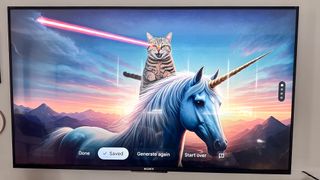
When comparing Roku vs Google TV, it's important to remember that their interface designs are similar. Access to streaming platforms is made incredibly simple with user-generated rows and tiles. Both come with a slew of ad-heavy banners and annoyances, but these are easily overlooked in the face of more egregious culprits on the market (like LG webOS and Fire TV).
Roku has its beloved Roku City screensaver page that many users adore for its myriad Easter eggs and mini-advertisements. It's nothing as profound as what can be found on the Google TV Streamer and its AI-fueled screensavers, though.
Several makers of the best TVs from the likes of Sony, Hisense, and TCL, have moved away from Roku in favor of Google TV. The major problem with Roku is that its personalization options are limited and doesn't allow for more advanced features like Google TV.
Google TV's initial set up stage is convenient, as it pulls many of your long-existing sign-ins to instantly log you into most applications. It's also got a robust for you section that knows exactly the type of content you're looking for.
But the best Roku TVs wouldn't be so sought after without a well-rounded system in place. Those already invested in the Roku ecosystem find its simple design worth sticking with, but it's often missing apps (like Twitch). Plus, Google TV even offers the Roku Channel, meaning you still get all the same free stuff on the Streamer as you would on the Ultra.
Winner: Google TV Streamer
Roku Ultra (2024) vs Google TV Streamer: Verdict
Both the Roku Ultra and Google TV Streamer offer exceptional features for those looking to upgrade an outdated TV, or for people who just want to switch their existing interface with one that's more aligned with their smart home ecosystem.
With both priced the same, it really comes down to your own preference and general needs. If you like the Roku interface over Google TV, the Ultra might be a better fit, especially if you already use several other Roku devices around your home. But it's no secret that Google TV is now winning the TV race — and for good reason.
The Google TV Streamer unlocks far more potential for users outside of the Roku brand with its Thread board router, not to mention its 1Gb internet potential over wired connection. The Roku Ultra might be faster than its predecessors, and even in the face of a better remote, Quick Media Switching and Wi-Fi 6 connectivity, its minimal upgrades aren't enough to overtake Google's more versatile streaming device.
More from Tom's Guide
Sign up now to get the best Black Friday deals!
Discover the hottest deals, best product picks and the latest tech news from our experts at Tom’s Guide.

Ryan Epps is a Staff Writer under the TV/AV section at Tom's Guide focusing on TVs and projectors. When not researching PHOLEDs and writing about the next major innovation in the projector space, he's consuming random anime from the 90's, playing Dark Souls 3 again, or reading yet another Haruki Murakami novel.